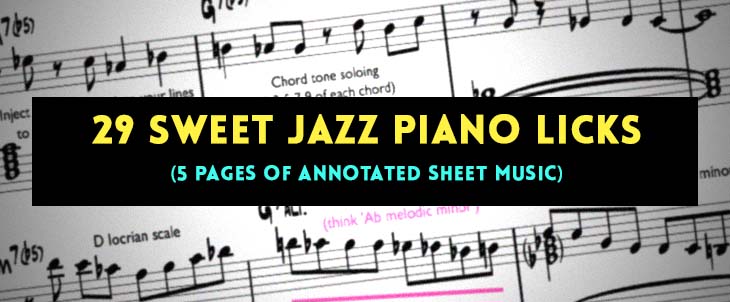The Altered Scale and Altered Chords for Jazz Piano
Here’s a great question from Mary in South Australia:
“When reading a lead sheet, how do you work out what to play in an altered chord? Thank you.”
Hi Mary, this is such a great topic:
Let’s cover both the altered scale and altered chords together in this email - since both go together…
What is the Altered Scale?
The altered scale is a complex type of jazz scale that can be played over V7 chords.
Here are the notes of C altered scale:
C Db Eb E F# Ab Bb
When played over a C7 chord - notice that this scale gives us the flat 9th (Db), sharp 9th (Eb), sharp 11th (F#), and the flat 13th (Ab).
That’s literally EVERY altered extension that exists over a C7 chord - (‘altered extension’ means a 9th, 11th or 13th that has been flattened or sharpened).
Here's a Shortcut
Most jazz musicians prefer to think of C altered scale as Db melodic minor scale.
It’s much easier to count up a half-step from the root of the chord (C - Db), and then play a melodic minor scale upwards.
Db Eb E Gb Ab Bb C
(The melodic minor scale is a minor scale up to the 5th, but with a major 6th and major 7th).
So if you see E7 and you want to play the altered scale - just count up a half-step from the chord’s root (E - F) - and then play F melodic minor scale (F G Ab Bb C D E).
Free Resource: Download my '29 Jazz Piano Licks' sheet music.
What are Altered Chords?
Melody and chords are always related - they’re built from the same scale, just played one note at a time (melody) or played together (chord).
So while you’re playing the altered scale in your right hand, you’ll need to play a chord voicing in your left hand that’s also built from the notes of the altered scale.
There are many ways to voice an altered chord (as with any chord).
Let me share a few options for C7 altered:
C E Bb (root - maj 3 - flat 7).
C / E Ab Bb Eb (‘rootless voicing’ played over the root)
C / Bb Eb E Ab (‘rootless voicing’ in inversion).
C E Bb / Eb Ab Db
C E Bb / C Eb Ab (upper structure)
Notice that none of these voicings has a natural 5th (G), because the altered scale does not have a natural 5th.
And all of these C7 altered voicings resolve naturally down a 5th to F minor 7, or F major 7:
F / Ab C Eb G or F / Eb G Ab C
How to write Altered chords
There are multiple ways to notate an altered chord in Jazz:
‘C7 alt.’ is the most obvious.
‘C7 b13’ is another way.
‘C7 #9 b13’ is another way.
Free Resource: Download my 'Jazz Piano Chord Voicing Guide' (11 pages).
What's the difference between the altered scale and the diminished scale?
The altered scale is very similar to the diminished scale - which can also be played over dominant 7 chords (V7 chords):
C diminished scale = C Db Eb E F# G A Bb
So if you see ‘flat 13’ after a dominant 7 chord (V7 chord) - that’s telling you ‘altered scale’.
The diminished scale has a natural 13th (A) instead.
As a jazz pianist, you can turn any V7 chord into a V7 altered chord. You don’t have to wait for an arranger to tell you ‘V7 alt’ or ‘V7 b13’ for you to use this chord.
Personally, I like to use the altered scale for minor 2-5-1 chord progressions (the V7 chord only), although they work just fine over the major 2-5-1 also (again, the V7 chord only).
Recommended Lesson
'Jazz Improvisation Explained in 18 Minutes'
These are the most-used improvisation techniques that you need to know about:
Free Resource: Download my '29 Jazz Piano Licks' sheet music.
What's Popular Now
'29 Jazz Piano Licks' sheet music

'Chord Voicing Guide for Jazz Piano'
This 11-page guide shows you chord voicings that professional Jazz pianists use.
6 pages of sheet music. Shares my top chord progressions and chord voicings.
One page cheat sheet. Shows you all common Jazz chords notated clearly:
